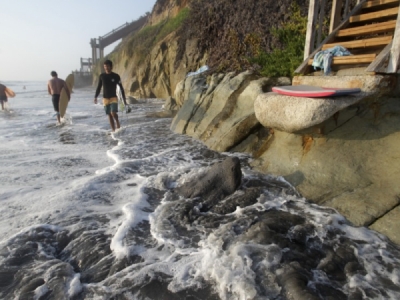
Posted on September 2, 2020
Planning, engineering & design to take three years
A long-anticipated project to beef up beaches in Solana Beach and Encinitas with sand delivered at five- and 10-year intervals for 50 years just got a little closer.
Solana Beach approved an agreement last week with Encinitas and the U.S. Army Corps of Engineers for the pre-construction engineering and design of the Coastal Storm Damage Reduction Project authorized by Congress in 2016.
“The good news is it’s moving forward,” Solana Beach City Manager Greg Wade said Thursday. “We approved the design agreement, and that’s a lot.”
The three-year planning, engineering and design phase of the program is expected to cost about $3 million. Most of the expense will be covered by federal and state grants already in hand. The two cities each have agreed to pay $75,000 as their share of the planning expense.
Sand dredged from nearby offshore sites could begin arriving on the shores of Solana Beach and Encinitas as early as 2024, Wade said.
Construction of the entire 50-year project was estimated at $167 million in 2015 costs, according to the Corps of Engineers. Completion depends on continued funding from the federal, state and local governments over the life of the effort.
Sand replenishment is considered the “soft solution” for shoring up San Diego County’s eroding beaches and bluffs. The other options include sea walls and revetments, often called “armoring” the coast. Environmentalists and the California Coastal Commission, which overseas all coastal development in the state, oppose armoring because studies show the structures can contribute to erosion.
Retreat is another option often discussed and requires removing structures in the path of erosion. While widely supported by environmentalists as the best solution, most coastal property owners would rather fight erosion than retreat from it.
“Beach nourishment,” another term for sand replenishment, delays the inevitable crumbling of coastal bluffs by building a blanket of sand that stops ocean waves before they hit the base of the cliffs. The practice, though expensive and temporary, is widely used along the California coast.

Congressional committees first authorized a sand project feasibility study for Encinitas in 1993 and for the adjoining city of Solana Beach in 1999. The two efforts were combined in 2000 and led to the work now planned.
“The project is intended to improve public safety, reduce coastal storm damage to property and infrastructure, and reduce coastal erosion and shoreline narrowing,” said Brooks Hubbard in the Los Angeles office of the Corps of Engineers.
Climate change and sea-level rise have hastened the pace of coastal erosion and emphasized the need to protect the 75-foot-tall, cliff-like bluffs. Occasional collapses endanger people on the beach and the homes above.
A bluff collapse last summer in Encinitas killed three people in a family sitting together on the beach and brought new attention to the problem. Congress allocated an additional $400,000 in February for the Corps of Engineers project.
The Solana Beach City Council unanimously declared “a climate emergency” at its meeting Wednesday, and called for accelerated action to address many aspects of the ecological crisis.
“Sea-level rise will exacerbate coastal flooding of low-level areas and beaches, already sand-starved due to river-damming and cliff stabilization,” the city’s resolution states.
Sand replenishment is part of the city’s strategy for adapting to sea-level rise, Wade said.
“It is vitality important to protect our bluffs and the homes along the bluffs,” he said. Also, the beaches are an important recreational resource for residents, visitors and tourists, and wider beaches are better.
Solana Beach will initially get about 700,000 cubic yards of sand to widen by 150 feet a 7,200-foot-long stretch of shoreline north and south of Fletcher Cove. Afterward that segment would get an additional 290,000 cubic yards of sand about every 10 years for the 50 years of the program.
Encinitas will initially get 340,000 cubic yards of sand to add 50 feet of beach along a 7,800-foot stretch of the coast between Beacons Beach to Boneyards. The Encinitas segment would get an additional 220,000 cubic yards of sediment about every five years over the life of the program.
Source: sandiegouniontribune





